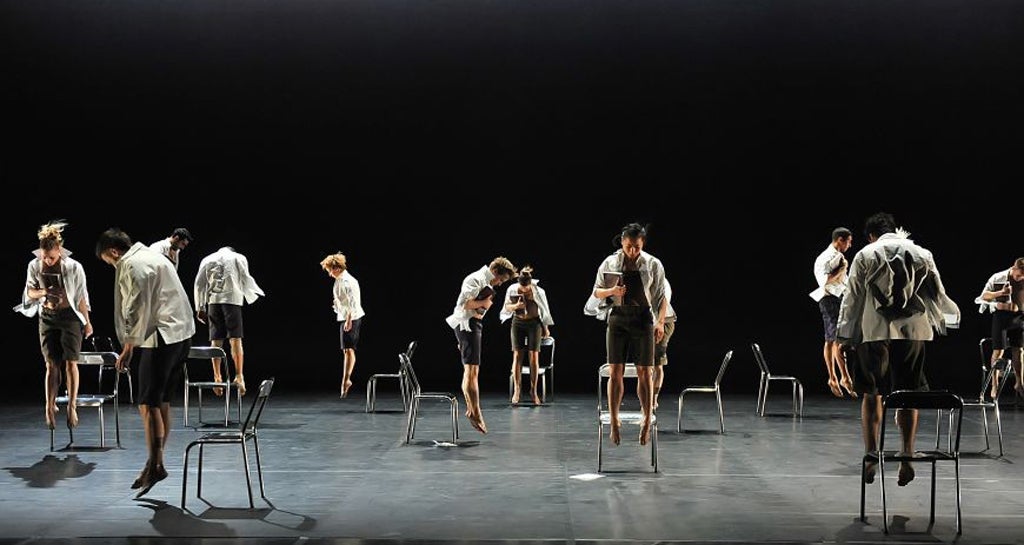And then, one thousand years of peace, Playhouse, Edinburgh Helikopter/Eldorado (Sonntags/Abschled), Playhouse, Edinburgh
This apocalyptic Zumba class has thriller moments and it's visionary in its power and strangeness – while a Stockhausen double bill is stranger yet

The island of Patmos is apparently flush with hallucinogenic mushrooms, which may have contributed to the more lurid fancies of its most famous inhabitant, St John, author of the Bible's Book of Revelation. Certainly Angelin Preljocaj's And then, one thousand years of peace, which was inspired by John's vision of the Apocalypse, is one of those spectacles which sometimes makes you think it would be really amazing if you were stoned, and sometimes leaves you wondering if perhaps you are.
To a soundtrack by DJ Laurent Garnier, it offers swarms of mutated and evolved humanity, beginning with women in flesh-coloured costumes taking a sort of dystopian Zumba class that turns them into scrolling rows of alphanumeric code. The arrival of some sharp-dressed suitors drives them to shelter under clear plastic sheets, where they hunker like chrysalides in the first sign of a sci-fi insect-alien theme that colours much of the work.
The violence that pervades And then, one thousand years of peace – there are chains, bloodlettings, biting and a scene where the dancers are hooded, like hostages, in national flags – is mostly perpetrated by men, but there is always the suggestion that at some point the women might turn and lay eggs in the bodies of their astonished, ambushed partners. Even a couple who could be angels, gliding past to an excerpt from Beethoven's Moonlight Sonata, have beetling thoracic bumps where their wings would be. Their serenity is a façade, and soon the placid rippling of the music is punctuated by the death-watch slap of their limbs against the stage.
This piece was originally made for dancers from both Ballet Preljocaj and the Bolshoi, then each company performed it independently. It would be fascinating to see how the Russians deal with these calculated inelegances. However, Preljocaj has a background in ballet, and combines a classicist's love of ranks and files with a modernist's disdain for prettifying them. At its best this produces severely mysterious close-formation manoeuvres, like an army drilled for a war against cliché; at its worst an MTV vacuity. The courtiers in his Snow White, seen recently at Sadler's Wells in London, could have stepped out of Adam Ant's "Prince Charming" video.
And then, one thousand years of peace has its "Thriller" moments (the flag-blinded hordes, initially a devastating image, lose their impact before they lose their livery) but they are submerged in an overwhelming flow of invention. From the fundamentalists who clamp books between their teeth so they protrude like the bills of cartoon birds, to the wandering lambs at the end, appropriately bemused symbols of innocence, this work is authentically visionary in its power and its strangeness.
Some things, though, are too strange for many, and it seems that putting the words "Karlheinz Stockhausen" and "double bill" on the same ticket is box-office poison, even at the Edinburgh Festival. This is the first time that Preljocaj has presented both his Stockhausen ballets in the same evening, and his daring alone deserved a bigger audience.
The composer was in full-on mad- scientist mode for Helikopter in 1995, later worked into Mittwoch. In both, the members of a string quartet play in separate helicopters above an auditorium, the resulting brutal mix of strings and rotors broadcast from speakers at ground level.
Preljocaj and lighting designer Patrick Riou rehumanise this Wagnerian conception by making every footfall – every bodily contact with the floor – generate ripples of light or shadow across the stage. So the dancers simulate, with their often doll-like movement, the effect of helicopter blades on grass or water, and evoke a fleeting fake arcadia from the aural wasteland of the score.
Both the music and the dance in Eldorado (Sonntags Abschied) are more self-consciously exalted. Twelve dancers stand against stone slabs, outlined in gold and with carved flowers making halos behind their heads. There is a casual kama sutra formality in the way they pair up and divide, and moments in the choreography are ravishing – a human temple built of spent and wilting bodies, or an encounter between two women that might almost be a grown-up version of the Puss in Boots duet from The Sleeping Beauty, with a hair-raising repertoire of scratching and grooming. But the erotic charge flickers in and out, and is not helped by the way that Stockhausen's synthesised choral oohs and ahhs can easily sound like a Teletubbies' birthday party.
Critic's Choice
The Edinburgh Festival ends with a little dark magic as St Petersburg's historic Mariinsky Ballet brings its nihilistic 21st-century Cinderella (created by ex-Bolshoi boss Alexei Ratmansky, music by Prokofiev) to the Alexei Ratmansky Edinburgh Playhouse (30 Aug-1 Sep)
Join our commenting forum
Join thought-provoking conversations, follow other Independent readers and see their replies
Comments